Race and Politics in Eighteenth-Century Mexico City: Architecture and Urbanism at the Shrine of Our Lady of Guadalupe
Abstract
:1. Introduction
2. The Myth and the Shrine
3. The Architecture of the Villa de Guadalupe Shrine Complex
4. The Urban Transformation of the Villa de Guadalupe
5. Conclusions: The Social and Racial Dynamics at Tepeyac, Our Lady of Guadalupe, and Criollismo
Funding
Data Availability Statement
Acknowledgments
Conflicts of Interest
| 1 | The narrative of the apparitions of the Virgin of Guadalupe comes from four primary works written in the colonial period. Together they are considered, to this day, the sources for Guadalupe’s apparitions and for the role played by Juan Diego and other characters in the narrative, as well as the role played by the site of Tepeyac Hill. The first narrative was written by the Creole priest Miguel Sánchez in 1648. Sánchez equated Guadalupe with the woman mentioned in the Book of Revelations. The next work, from 1649, is perhaps the most widely read to this day, as it is argued that it was based on Indigenous accounts of the apparitions and miracles performed by the Virgin. It is attributed to Antonio Valeriano, an Indigenous scholar. However, the account was published by Luis Lasso de la Vega, and many attribute the authorship of this account, popularly known as Nican Mopohua, Nahuatl for “Thus It Is Told”, to Lasso himself, who was a Creole priest and lawyer. The third canonical text was written by the Creole scholar and erudite Luis Becerra Tanco in 1666. It was his revised version of the events that he claimed were based on primary manuscripts and documents. The fourth text, widely cited and studied too, was written by the Jesuit Creole priest Francisco de Florencia in 1688, which he based, in turn, on a manuscript that belonged to the Creole scholar Carlos de Sigüenza y Góngora. Overall, it is evident how the role played by Creole clerics and scholars was critical in the articulation of the Virgin of Guadalupe narrative. See: (Sánchez 1648; Valeriano 1649; Becerra Tanco 1675; de Florencia 1895). |
| 2 | The scholar Stafford Poole set 1648 as the key year in which Guadalupe became part of a clearly Creole cult that was not associated to the Indigenous population, while other scholars like Cornelius Conover believe its cult only took off until the 1760s thanks to the Creole community, remaining only a marginal worship until that period. William Taylor, on the other hand, sticks to 1754, the year of the Pope’s official confirmation of the Virgin’s role as patroness of New Spain, as the date in which her cult became diffused to the rest of the viceroyalty. Yet others, like Jeannette Favrot Peterson, asserted that the Guadalupian devotion was born a Creole one, and only took up amongst the “disenfranchised” population of Mexico until the nineteenth century. See: (Poole 1995, p. 10; Conover 2011, pp. 251–79; Peterson 1992, p. 39; Taylor 1987, p. 12). |
| 3 | In my definition of criollismo, I employ the work of several authors, from Edmundo O’Gorman, a preeminent Mexican historian, who coined the term criollismo, to the Mexican scholars Solange Alberro and Antonio Rubial, and Englsh-speaking scholars, such as David Brading, Anna More, among others. The list of authors consulted is too long to reference here. The work by More and her concept of the “Creole Archive”, the body of writings, objects, attitudes, architecture, and more, that they crafted and which speak of their collective identity, is particularly illuminating, as were the writings by Alberro, who skillfully described the history of cultural and religious sensitivities of Mexican Creoles in her work, while the writings by O’Gorman, Brading, and Rubial, all contributed clear historical references to track the development of criollismo throughout the viceregal Mexican period. See: (Alberro 1992; Brading 2003, chaps. XII through XXIX, pp. 283–728; O’Gorman 1975; More 2013, Introduction, pp. 1–28; Rubial García 2010, Sections II through V, pp. 59–464). |
| 4 | The topic of criollismo is so vast and has been researched by such a great deal of scholars, at a Spanish American level and at regional levels too, particularly in colonial Mexico, the Caribbean region, and the Andean nations, that it goes beyond the scope of this essay to review the literature. A few basic sources to delve into this topic for New Spain are: (Brading 2003, chap. XIV: Los patriotas criollos, pp. 323–44; Brading 2015, chap. III. Peregrinos en su propia patria: Patriotimos criollo e identidad en la América española, pp. 84–124; Cañizares-Esguerra 2001, chap. 4: The Making of a “Patriotic Epistemology,” pp. 204–65; O’Gorman 1975, pp. 84–99; More 2013, pp. 1–28; Rubial García 2010, chap. III.2. Los encomenderos criollos sueñan la conquista, pp. 131–39, chap. IV.1. Los paraísos terrenales en las patrias criollas). |
| 5 | The cult to Our Lady of Guadalupe has fascinated researchers for generations. The literature on the topic being enormous, the following works are but a small sample of anthropological, historical, art historical, and theological frameworks through which the icon has been analyzed: (Burkhart 2001; Peterson 1992; Gruzinski 1994; Lafaye 2015; Taylor 1987; Poole 1995). |
| 6 | The architecture of the original shrine of Our Lady of Guadalupe and of other landmarks that are part of the shrine complex built during the colonial period has received some attention from art and architectural historians, mostly in Spanish by Mexican or Hispanic scholars. While they all acknowledge the critical role played by Creole agents in the making of this shrine complex, from high clerical administrators to lay priests, members of religious orders, particularly the Jesuits, and architects, no study has looked at the site in its entirety from a criollismo framework to understand it as a whole, but rather as different buildings, while the site and its urban development have been studied separately from the architecture. For some of the most relevant writings on this topic, see: (Amerlinck de Corsi 2010; Cuesta Hernández 2009, 2015; Fernández 2011, 2003b; López Sarrelangue 2005; Toussaint 1967). |
| 7 | See note 2 above. |
| 8 | Scholars, such as Edmundo O’Gorman and Francisco de la Maza, who are skeptical of the shrine’s origin story as told by chroniclers such as Florencia and Sánchez, have speculated that a shrine existed at Tepeyac since the early 16th century, maybe built by Franciscan missionaries, and perhaps populated by the image of the Guadalupe icon from Extremadura, which was later replaced by the Mexican Guadalupe image. See: (Watson Marrón 2012, pp. 53–54, f.n. 32). |
| 9 | For a point of reference, Cuesta argues that the Professed House, a large and luxurious religious building that included a church building and a professed house next to it built by the Jesuit Order, cost one hundred and twenty thousand pesos (Cuesta Hernández 2009, p. 104). |
| 10 | Although attributed to Guerrero y Torres, the Chapel of the Hill’s façade and its estípite-based decorative arrangement, popularized by Lorenzo Rodríguez in Mexico City and his Cathedral’s Sagrario from the mid-eighteenth century, is unusual for Guerrero y Torres (Sentíes R. 1991, p. 168). |
| 11 | Two files kept at the Archivo Histórico de la Ciudad de México (AHCM) testify to the Shrine Collegiate Council’s attempts to have the Spanish Crown and the Mexico City Council name the town of Guadalupe into a veritable Villa. In them, long pleads filled with arguments in favor of the Villa’s creation, despite the Crown’s pushback given the lack of a large tax base due to a small population and a lack of natural resources, shed clarity on how important the project was to the Creoles behind the project. Together with the urban plans drawn by Creole architects such as Guerrero y Torres, Iniesta Bejarano, and Felipe Feringán, among others, and pleas to have the cigar factory moved from Mexico City to the town of Guadalupe and other solutions proposed by the Collegiate Council of the Guadalupe Shrine to concretize the Villa of Guadalupe project, it is evident that the project was critical to the Creole community. AHCM, Ayuntamiento, Villa de Guadalupe, volume 4297, File 5, 1742; Ayuntamiento, Villa de Guadalupe, Volume 4299, File 15, 1787. |
| 12 | Altépetl, is a Nahuatl term composed of the words atl (water) and tépetl (mountain or hill). It is closely associated to the Western notions of a city or urban settlement, but are not quite equivalent, in that an altepetl considers the interrelation between the natural and built environments, and the notion of polity and population, as being interrelated. The term refers, in poetic terms, to the relation between the element of water as a source of life and a sacred mountain, an axis mundi that in Mesoamerican culture points toward the relationship between the heavens and the earth. For further clarification see: (Fernández Christlieb and García Zambrano 2006, pp. 31–100). |
| 13 | Specifically, in a file found at the Archivo Histórico de la Ciudad de México, a document authored by the Abott and the council of the Colegiata de Guadalupe, or Collegiate Council of the Guadalupe Shrine, cites two precedents in Spain to argue in favor of Guadalupe’s urban reforms and its imbricated relationship with Mexico City. One is the town of Caudete, in the region of Valencia, which is a small town connected to the town of Villena by way of a long avenue. Caudete displays an ordered grid in its urban design, similar to the plans by the Creole architects for Guadalupe. The second precedent is the town or suburb of Zarramalama, northwest of Segovia, Spain. This small town is also connected to the bigger settlement, Segovia, via a long avenue. AHCM, Ayuntamiento, Villa de Guadalupe, expediente 15, vol. 4299, 1787, 15–16. |
| 14 | Spaniards originally employed the word as a derogatory label, and it was originally used to refer to Black slaves. |
| 15 | See note 2 above. |
| 16 | From the devotion to Our Lady of Guadalupe expressed by the second Archbishop of Mexico, Alonso de Montúfar, in the sixteenth century, to the late seventeenth-century lobbying by the Creole elite to build a new shrine, to the Creole boosting of Guadalupe’s status to the patroness of New Spain, the negotiations between the Spanish high clergy and the Creole community were key to the building of Guadalupe’s cult. See: (Poole 1995, pp. 58–59, 172; Watson Marrón 2012, p. 171 and ss.). |
| 17 | A great number of sermons were written during the colonial period, during the seventeenth and eighteenth centuries to the Virgin of Guadalupe. The literature on them is vast. As an example, Jorge Traslosheros analyzes three of them in this article: (Traslosheros 1998). |
| 18 | A collegiate church is one that is run and administered by a collegiate body or council of priests, who oversee rituals that are similar to those of a cathedral. |
References
Archives
AHCM. Archivo Histórico de la Ciudad de MéxicoAGI. Archivo General de IndiasSources
- Aguilera, Carmen. 2000. Las deidades prehispánicas en el Tepeyac. In Tepeyac; Estudios Históricos. Mexico City: Universidad del Tepeyac A.C, pp. 31–42. [Google Scholar]
- Alberro, Solange. 1992. Del gachupín al criollo, o cómo los españoles de México dejaron de serlo, Open Access Electronic ed. Funded by the NEH and Mellon Foundation. Mexico City: El Colegio de México. [Google Scholar]
- Álvarez Álvarez, Arturo. 2006. Guadalupe de España en el México del siglo XVI. Revista de Estudios Extremeños 62: 389–410. [Google Scholar]
- Amerlinck de Corsi, María Concepción. 2010. El santuario de Nuestra Señora de Guadalupe en 1709. Boletín de Monumentos Históricos—Tercera Época 20: 17–25. [Google Scholar]
- Becerra Tanco, Luis. 1675. Felicidad de México en el principio, y milagroso origen, que tubo el Santuario de la Virgen María N. Señora de Guadalupe. Mexico City: Imprenta de la Viuda de Bernardo Calderón. Available online: https://archive.org/details/A093073/page/n3/mode/2up (accessed on 1 August 2023).
- Bérchez, Joaquín. 1992. Arquitectura Mexicana de los Siglos XVII y XVIII. Arte Novohispano. Mexico City: Grupo Azabache. [Google Scholar]
- Brading, David A. 2003. Orbe indiano: De la monarquía católica a la república criolla, 1492–1867. Mexico City: Fondo de Cultura Económica. [Google Scholar]
- Brading, David A. 2015. La Nueva España. Patria y Religión. Mexico City: Fondo de Cultura Económica. [Google Scholar]
- Burkhart, Louise M. 2001. Before Guadalupe: The Virgin Mary in Early Colonial Nahuatl Literature. Austin: University of Texas Press. [Google Scholar]
- Cañizares-Esguerra, Jorge. 2001. How to Write the History of the New World: Historiographies, Epistemologies, and Identities in the Eighteenth-Century Atlantic World. Stanford: Stanford University Press. [Google Scholar]
- Chargoy Ruiz, Daniel. 2020. Evolución urbana de la Villa de Guadalupe durante los siglos XVIII al XX. Historias 102: 25–43. [Google Scholar]
- Conover, Cornelius. 2011. Reassessing the Rise of Mexico’s Virgin of Guadalupe, 1650s–1780s. Mexican Studies/Estudios Mexicanos 27: 251–79. [Google Scholar] [CrossRef]
- Coogan, Michael D., Marc Z. Brettler, Carol A. Newsom, and Pheme Perkins, eds. 2010. The New Oxford Annotated Bible with Apocrypha, NRSV, 4th ed. Oxford: Oxford University Press. [Google Scholar]
- Cuesta Hernández, Luis Javier. 2009. ‘La mayor fábrica que en este tiempo se ha ofrecido, que es la iglesia de Nuestra Señora de Guadalupe’. La construcción del templo. Algunas cuestiones. In Tres Siglos en el Tepeyac: El Antiguo Templo y Morada de Guadalupe (1709–2009). Mexico City: Museo de la Basílica de Guadalupe, pp. 99–139. [Google Scholar]
- Cuesta Hernández, Luis Javier. 2015. Palacios de Dios, cielos en la Tierra: Homilética y arquitectura en Nueva España en el siglo xvii. Anales del Museo de América 23: 114–28. [Google Scholar]
- de Florencia, Francisco. 1895. La Estrella del Norte de México. Historia de la Milagrosa Imagen de Maria Santísima de Guadalupe, escrita en el siglo XVII por el P. Francisco de Florencia. Guadalajara: Imprenta de J. Cabrera. [Google Scholar]
- de Florencia, Francisco. 1898. Narración de la maravillosa aparición que hizo el Arcángel San Miguel a Diego Lázaro de San Francisco, Indio feligrés del Pueblo de S. Bernabé, de la Jurisdicción de Sta. María Natívitas. Fundación del Santuario que llaman S. Miguel del Milagro, de la Fuente Milagrosa. Puebla: Colegio Pio de Artes y Oficios. [Google Scholar]
- Fernández Christlieb, Federico, and Angel Julián García Zambrano. 2006. Territorialidad y paisaje en el altepetl del siglo XVI. Mexico City: Fondo de Cultura Económica. [Google Scholar]
- Fernández, Martha. 2003a. La imagen del Templo de Jerusalén en la Nueva España, 1st ed. Colección de Arte 52. Mexico City: UNAM. [Google Scholar]
- Fernández, Martha. 2003b. Cristobal de Medina Vargas y la arquitectura salomónica en la Nueva España del siglo XVII. Mexico City: UNAM. [Google Scholar]
- Fernández, Martha. 2011. Estudios sobre el simbolismo en la arquitectura novohispana. México: UNAM-INAH. [Google Scholar]
- Giuriati, Paolo, and Elio Masferrer Kan. 1998. No temas… yo soy tu madre: Un estudio socioantropológico de los peregrinos a la Basílica de Guadalupe. Mexico City: Plaza y Valdes. [Google Scholar]
- Goicoechea, Juan de. 1695. La Maravilla Immarcescible, y Milagro Continuado de María Santíssima Señora Nuestra, en su Prodigiosa Imagen de Guadalupe de México. Mexico City: Imprenta de los Herederos de Juan José Guillena Carrasoso. [Google Scholar]
- González Galván, Manuel. 2006. Génesis Del Barroco y Su Desarrollo Formal En México. In Trazo, Proporción y Símbolo En El Arte Virreinal. Mexico City: UNAM, Instituto de Investigaciones Estéticas, Gobierno del Estado de Michoacán, Secretaría de Cultura, pp. 167–202. [Google Scholar]
- Gruzinski, Serge. 1994. La guerra de las imágenes: De Cristóbal Colón a Blade Runner, 1st ed. Translated by Juan José Utrilla. Mexico City: Fondo de Cultura Económica. [Google Scholar]
- La redacción de El Economista. 2021. Gobierno de CDMX Prevé La Visita de Más de 4 Millones de Peregrinos a La Basílica de Guadalupe. El Economista. November 11. Available online: https://www.eleconomista.com.mx/estados/Gobierno-de-CDMX-preve-la-visita-de-mas-de-4-millones-de-peregrinos-a-la-Basilica-de-Guadalupe-20211211-0025.html (accessed on 1 June 2023).
- Lafaye, Jacques. 2015. Quetzalcóatl y Guadalupe. La formación de la conciencia nacional en México, First Electronic ed. Mexico City: Fondo de Cultura Económica. [Google Scholar]
- Loera Fernández, Gabriel. 1982. Francisco Antonio Guerrero y Torres, arquitecto y empresario del siglo XVIII. Boletín de Monumentos Históricos-Primera Época 8: 61–84. [Google Scholar]
- López Sarrelangue, Delfina. 2005. Una villa mexicana en el siglo XVIII: Nuestra Señora de Guadalupe. Mexico City: UNAM, Instituto de Investigaciones Históricas-Miguel Ángel Porrúa Editores. [Google Scholar]
- Martínez Baracs, Rodrigo. 2000. Tepeyac en la conquista de México. Problemas historiográficos. In Tepeyac: Estudios Históricos. Mexico City: Universidad del Tepeyac A.C., pp. 55–118. [Google Scholar]
- Martínez, María Elena. 2008. Genealogical Fictions: Limpieza de Sangre, Religion, and Gender in Colonial Mexico. Stanford: Stanford University Press. [Google Scholar]
- More, Anna Herron. 2013. Baroque Sovereignty: Carlos de Sigüenza y Góngora and the Creole Archive of Colonial Mexico, 1st ed. Philadelphia: University of Pennsylvania Press. [Google Scholar]
- O’Gorman, Edmundo. 1975. Meditaciones sobre el criollismo. Memorias de la Academia Mexicana. Discursos de Recepción, Homenajes, Oraciones Fúnebres, Noticias XXI: 84–99. [Google Scholar]
- Patton, Glenn Neil. 1958. Francisco Antonio Guerrero y Torres and the Baroque Architecture of Mexico City in the Eighteenth Century. Ann Arbor: University of Michigan. [Google Scholar]
- Peterson, Jeanette Favrot. 1992. The Virgin of Guadalupe: Symbol of Conquest or Liberation? Art Journal 51: 39–47. [Google Scholar] [CrossRef]
- Poole, Stafford. 1995. Our Lady of Guadalupe: The Origins and Sources of a Mexican National Symbol, 1531–1797. Tucson: University of Arizona Press. [Google Scholar]
- Rubial García, Antonio. 2010. El paraíso de los elegidos: Una lectura de la historia cultural de Nueva España (1521–1804), 1st ed. Mexico City: FCE-UNAM. [Google Scholar]
- Saldaña Solís, Marcela. 2017. Proyecto de reparación en la capilla del Sagrario anexa a la Colegiata de Guadalupe, 1878–1879. Boletín de Monumentos Históricos, Tercera Época 41: 54–75. [Google Scholar]
- Sánchez, Miguel. 1648. Imagen de la Virgen María madre de Dios de Guadalupe, milagrosamente aparecida en la Ciudad de México. Mexico City: Imprenta de la Viuda de Bernardo Calderón. Available online: https://www.cervantesvirtual.com/obra/imagen-de-la-virgen-maria-madre-de-dios-de-gvadalupe-milagrosamente-aparecida-en-la-ciudad-de-mexico/ (accessed on 8 September 2023).
- Sentíes R., Horacio. 1991. La Villa de Guadalupe. Historia, Estampas y Leyendas. Mexico City: Departamento del Distrito Federal. [Google Scholar]
- Serlio, Sebastiano. 1544. Il terzo libro di Sabastiano Serlio bolognese, nel qual si figurano, e descrivono le antiquita di Roma e le altre che sono in Italia, e fuori d’Italia. Venice: Francesco Marcolini. [Google Scholar]
- Sigaut, Nelly. 2006. Imágenes y devociones en el antiguo santuario de la Virgen de Guadalupe. In Felicidad de México. 475 años de Santa María de Guadalupe en el arte. Mexico City: Insigne y Nacional Basílica de Guadalupe, pp. 101–18. [Google Scholar]
- Taylor, William. 1987. The Virgin of Guadalupe in New Spain: An Inquiry into the Social History of Marian Devotion. American Ethnologist 14: 9–33. [Google Scholar] [CrossRef]
- Toussaint, Manuel. 1967. Colonial Art in Mexico. Austin: University of Texas Press. [Google Scholar]
- Traslosheros, Jorge E. 1998. Santa María de Guadalupe: Hispánica, novohispana y mexicana. Tres sermones y tres voces guadalupanas. 1770–1818. Estudios de Historia Novohispana 18: 83–103. [Google Scholar] [CrossRef]
- Urquijo Torres, Sergio. 2009. Vistas de la Villa: El Cerro y el santuario. La perspectiva de paisaje. In Tres siglos en el Tepeyac. El antiguo templo y morada de Guadalupe (1709–2009). Mexico City: Museo de la Basílica de Guadalupe, pp. 65–97. [Google Scholar]
- Valeriano, Antonio. 1649. Huei Tlamahuizoltica Omonoxiti Ilhuicac Tlatoca Ihwapilli Sancta María (a.k.a. Nican Mopohua, “Thus It Is Told”). Mexico City: Imprenta de Juan Ruiz. Available online: https://archive.org/details/virgendeguadalupenahuatl/page/n1/mode/2up (accessed on 8 September 2023).
- Watson Marrón, Gustavo. 2012. El templo que unió a Nueva España. Mexico City: Miguel Angel Porrúa, Arzobispado de México. [Google Scholar]
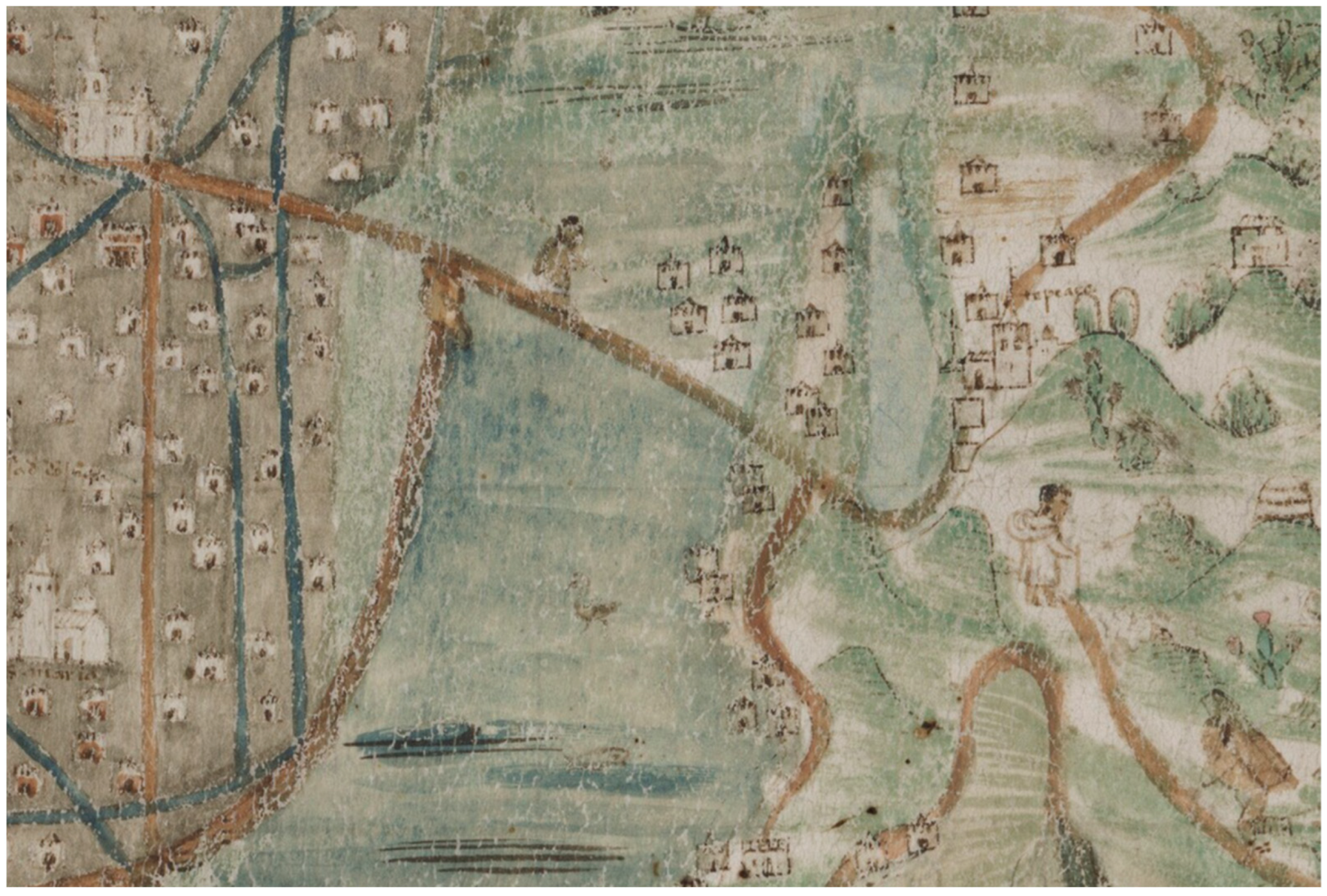


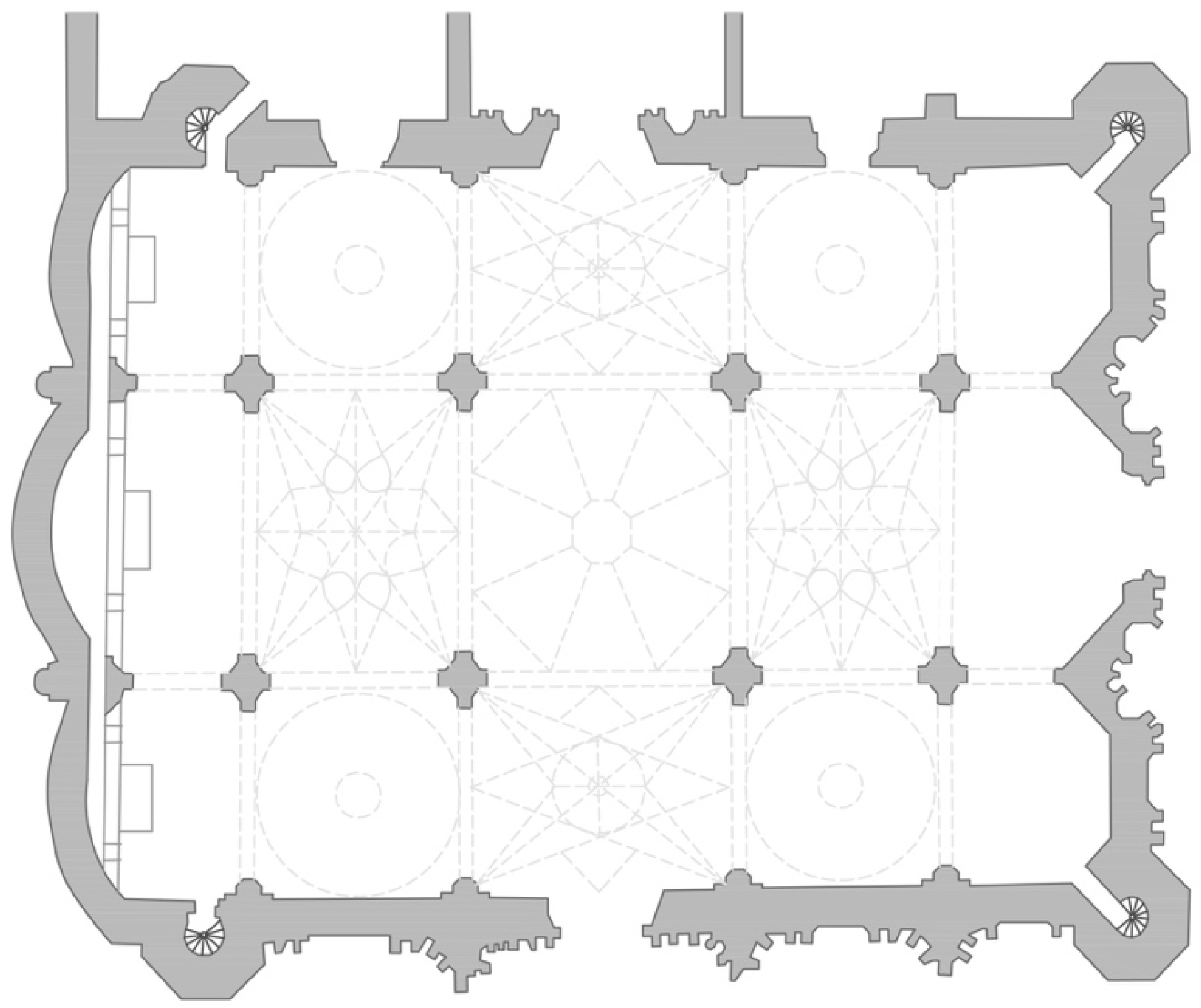
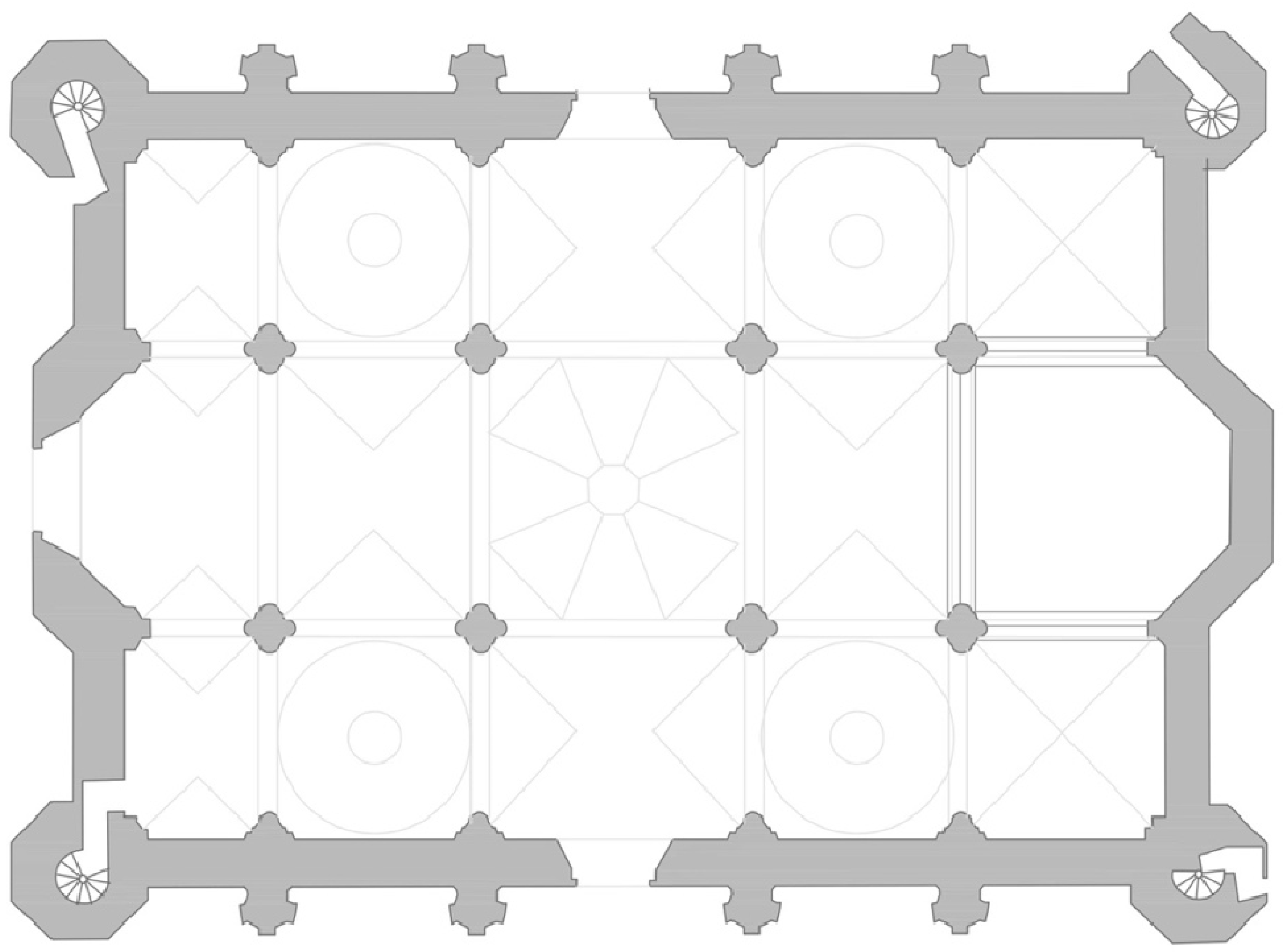
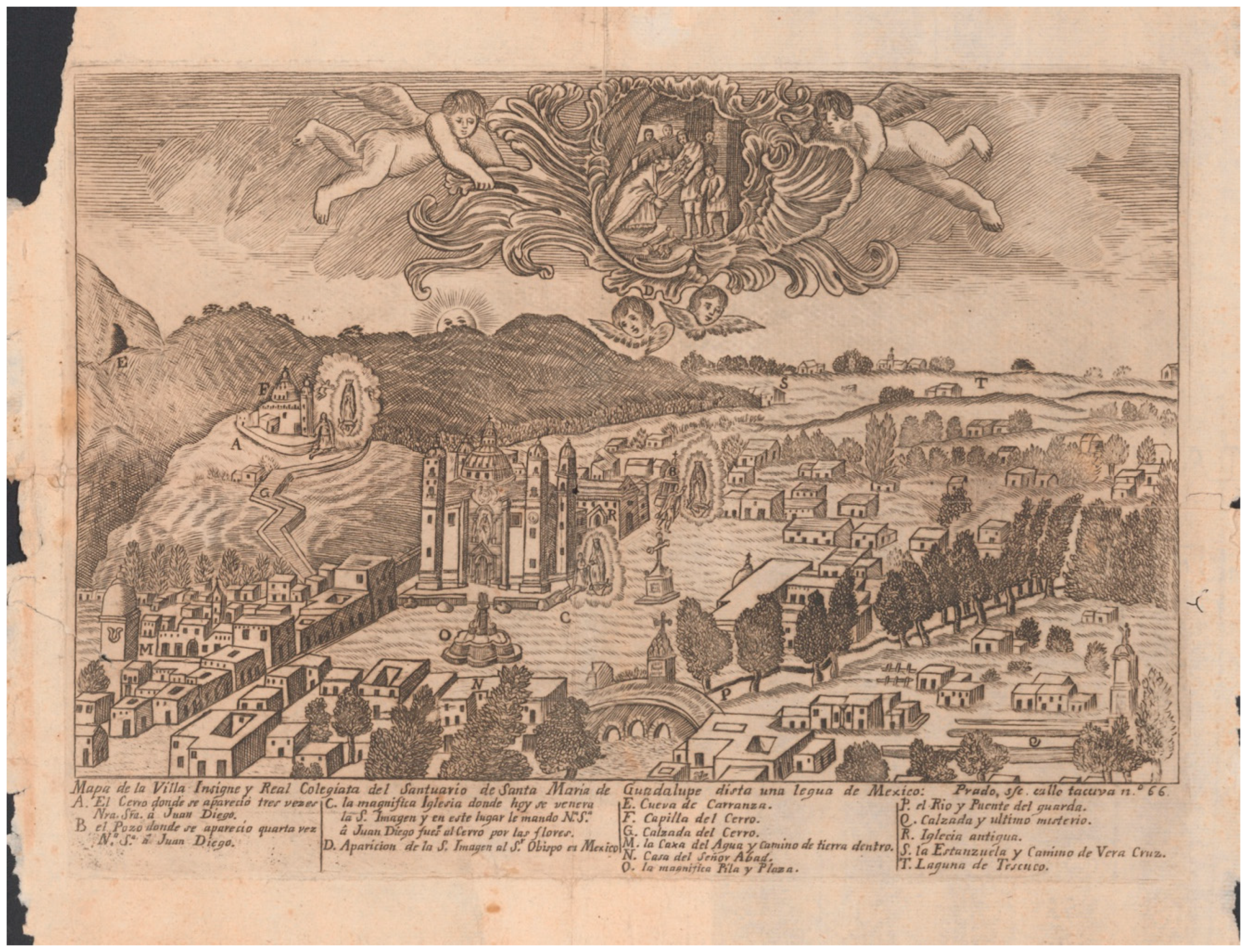
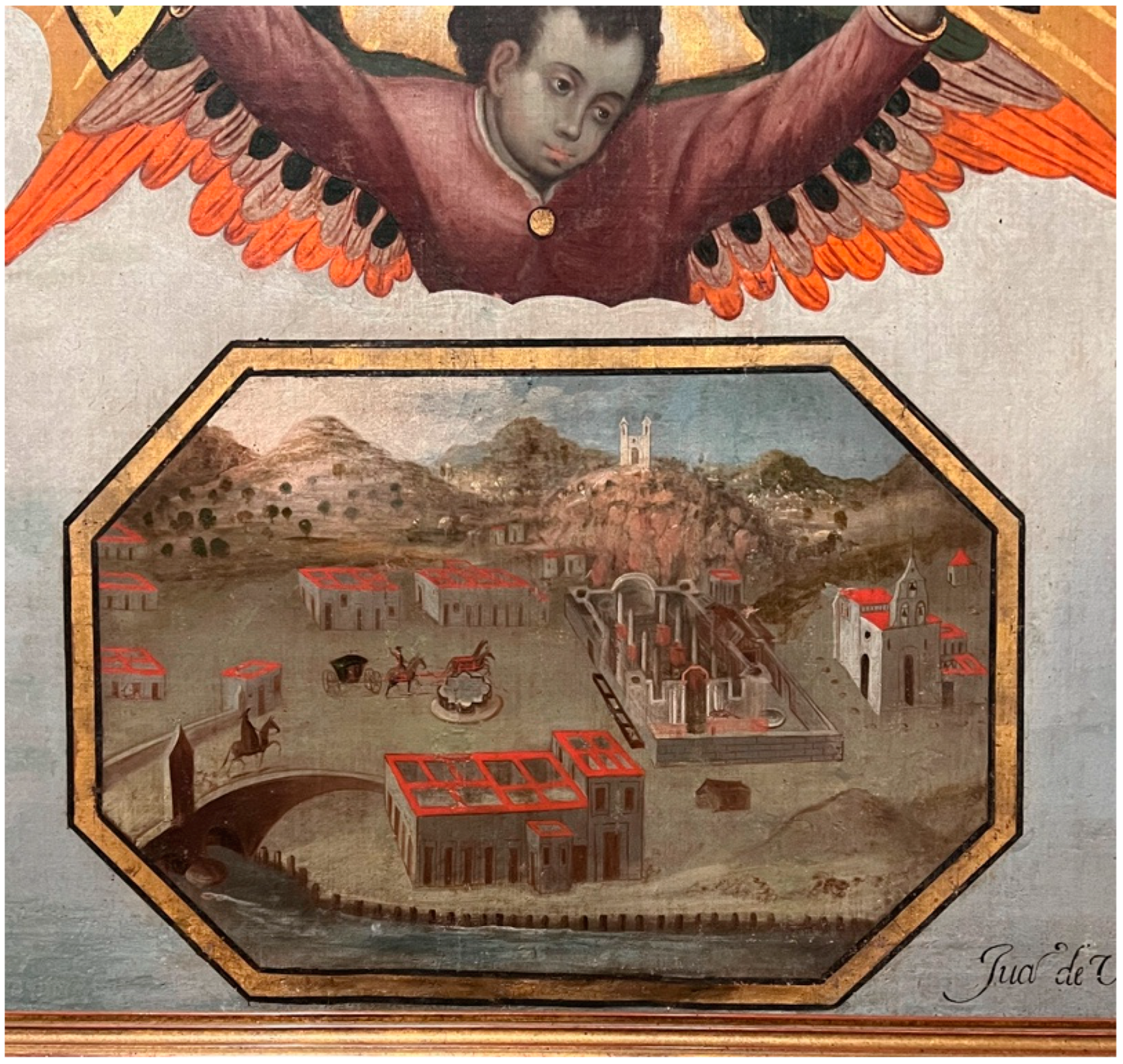


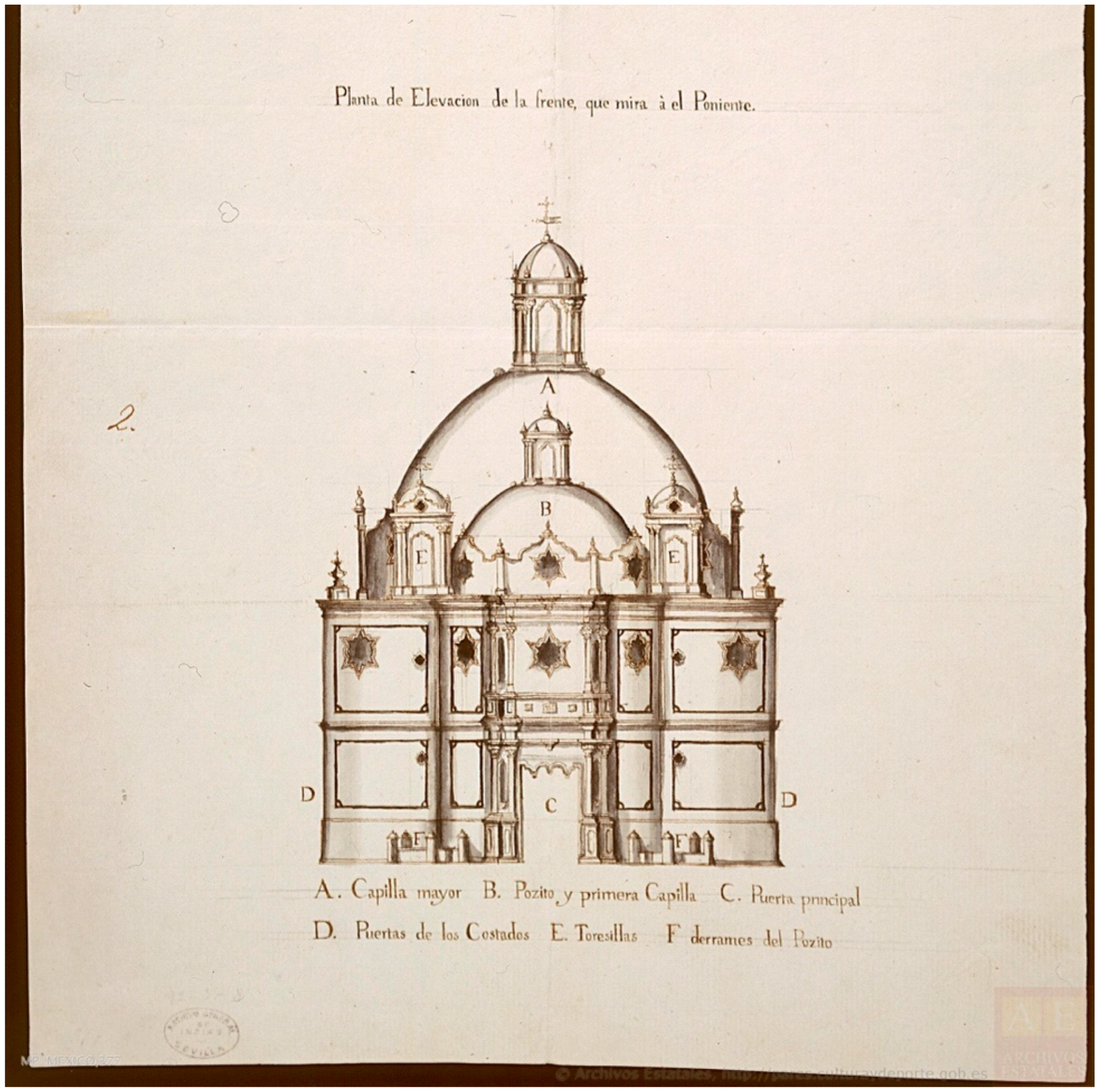




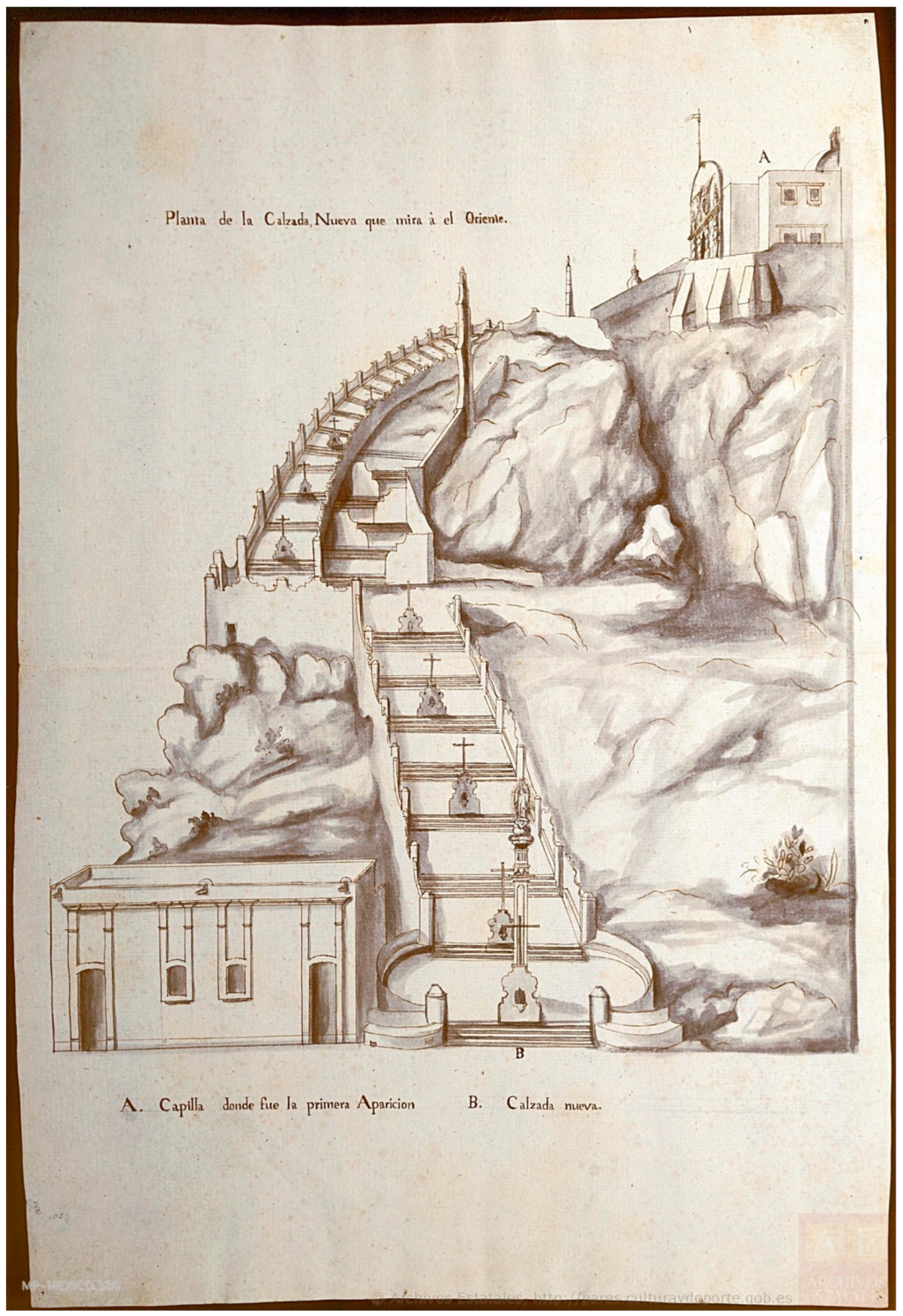




Disclaimer/Publisher’s Note: The statements, opinions and data contained in all publications are solely those of the individual author(s) and contributor(s) and not of MDPI and/or the editor(s). MDPI and/or the editor(s) disclaim responsibility for any injury to people or property resulting from any ideas, methods, instructions or products referred to in the content. |
© 2023 by the author. Licensee MDPI, Basel, Switzerland. This article is an open access article distributed under the terms and conditions of the Creative Commons Attribution (CC BY) license (https://creativecommons.org/licenses/by/4.0/).
Share and Cite
Burke, J.L. Race and Politics in Eighteenth-Century Mexico City: Architecture and Urbanism at the Shrine of Our Lady of Guadalupe. Arts 2023, 12, 250. https://doi.org/10.3390/arts12060250
Burke JL. Race and Politics in Eighteenth-Century Mexico City: Architecture and Urbanism at the Shrine of Our Lady of Guadalupe. Arts. 2023; 12(6):250. https://doi.org/10.3390/arts12060250
Chicago/Turabian StyleBurke, Juan Luis. 2023. "Race and Politics in Eighteenth-Century Mexico City: Architecture and Urbanism at the Shrine of Our Lady of Guadalupe" Arts 12, no. 6: 250. https://doi.org/10.3390/arts12060250
APA StyleBurke, J. L. (2023). Race and Politics in Eighteenth-Century Mexico City: Architecture and Urbanism at the Shrine of Our Lady of Guadalupe. Arts, 12(6), 250. https://doi.org/10.3390/arts12060250






